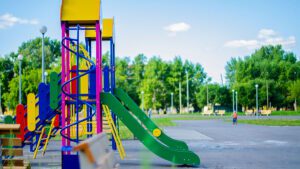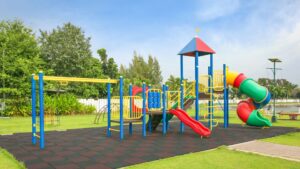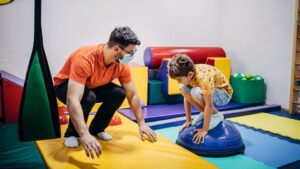Крытые игровые площадки стали важными общественными центрами, предлагая безопасную, защищенную от непогоды среду, где дети всех возрастов могут играть, учиться и общаться. Хорошо спроектированные крытые игровые площадки используют различные конструкции для стимулирования воображения, развития моторики и поощрения сотрудничества. В этой статье мы рассмотрим пять основных типов конструкций крытых игровых площадок, их преимущества и советы по проектированию, которые помогут вам создать динамичное и увлекательное игровое пространство.

1. Лазающие конструкции
Что они собой представляют
Конструкции для лазания - это модульные игровые системы, состоящие из лестниц, веревочных сеток, грузовых лазов и туннелей. Они могут варьироваться от простых одноуровневых рам до многоуровневых игровых крепостей с подвесными мостами и смотровыми площадками.
Преимущества
- Развитие крупной моторики: Скалолазание развивает силу верхней части тела и сердечника, поскольку дети тянут, толкают и балансируют.
- Решение проблем: Дети должны планировать маршруты и преодолевать препятствия, развивая когнитивную гибкость.
- Уверенность и оценка риска: Успешное завершение восхождения повышает самооценку и учит безопасному риску.
Советы по дизайну
- Предусмотрите различные уровни сложности: пологие пандусы для малышей и более крутые сетки для детей постарше.
- Обеспечьте безопасные зоны падения с помощью ударопоглощающих покрытий, таких как резиновая плитка или древесное волокно.
- Используйте красочные панели или тематические элементы (лианы джунглей, пиратский такелаж), чтобы разбудить воображение.

2. Мягкие игровые конструкции
Что они собой представляют
В мягких игровых зонах используются мягкие поролоновые элементы - блоки, туннели, горки и ямы для мячей - покрытые прочными виниловыми чехлами. Идеально подходящие для малышей и дошкольников, эти зоны уделяют первостепенное внимание безопасности и сенсорному исследованию.
Преимущества
- Безопасное исследование: Мягкие поверхности минимизируют риск травм для новичков, которые еще только оттачивают двигательные навыки.
- Тактильное взаимодействие: Мягкие текстуры располагают к ползанию, катанию и малотравматичному лазанию.
- Социальная игра: Закрытые макеты способствуют совместной игре и групповым играм.
Советы по дизайну
- Создавайте зоны, разделенные по возрасту, с невысокими стенами, чтобы отделить детей младшего возраста от более активных игр.
- В пенопластовые стены вмонтируйте прозрачные окна, чтобы воспитатели могли наблюдать за всеми действиями.
- Добавьте тематические мягкие препятствия - грибы из пенопласта или валуны, - чтобы оживить пространство.
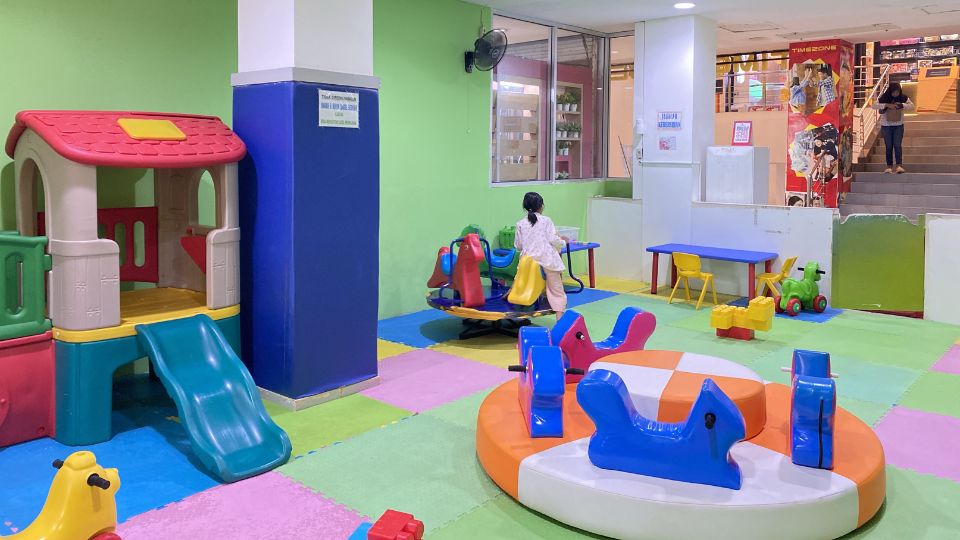
3. Сенсорные структуры
Что они собой представляют
Сенсорные конструкции задействуют пять органов чувств и помогают детям с сенсорными нарушениями. Как правило, это тактильные панели, зеркальные стены, световые туннели и музыкальные игровые станции.
Преимущества
- Сенсорная интеграция: Мультисенсорное воздействие помогает детям регулировать свои реакции на прикосновение, звук и свет.
- Зоны успокоения: Тихие сенсорные уголки с мягким освещением и нежными текстурами - это убежище для перевозбужденных детей.
- Инклюзивная игра: В нем могут заниматься дети с расстройством аутистического спектра (ASD), СДВГ и другими сенсорными проблемами.
Советы по дизайну
- Сбалансируйте зоны с высоким уровнем стимуляции (барабанные панели, пузырьковые трубы) с зонами с низким уровнем стимуляции (тканевые уголки).
- Используйте регулируемое освещение и регуляторы громкости, чтобы настроить сенсорный уровень.
- Убедитесь, что все материалы нетоксичны и легко моются.
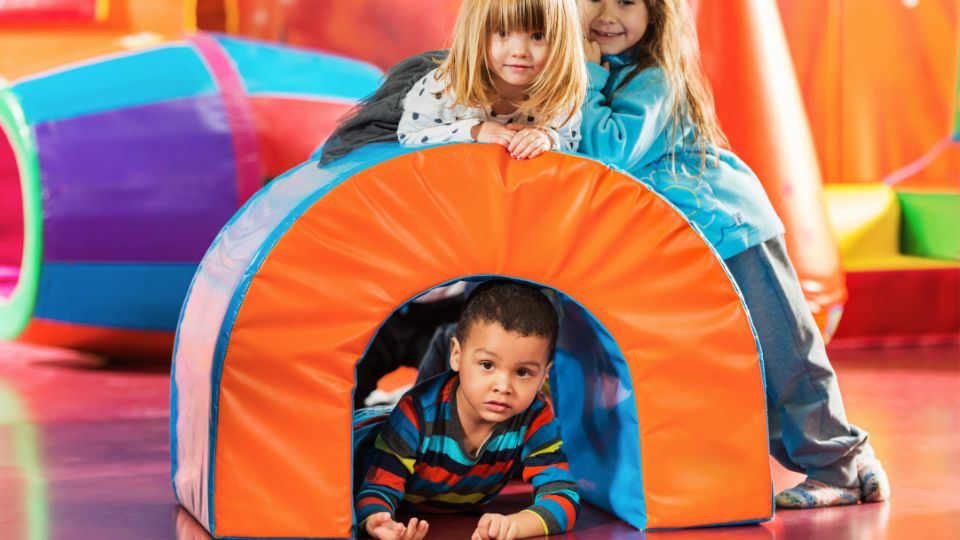
4. Ролевые игры и тематические структуры
Что они собой представляют
Ролевые зоны имитируют реальную обстановку - мини-кухни, продуктовые магазины, пожарные станции или пиратские корабли - с реквизитом, костюмами и уменьшенной мебелью.
Преимущества
- Развитие воображения: Дети практикуют язык, социальные роли и навыки повествования.
- Социальное взаимодействие: Совместные сценарии способствуют переговорам, обмену опытом и сопереживанию.
- Ранняя грамотность и математика: Игра в магазин или ресторан включает в себя счет, чтение меню и следование рецептам.
Советы по дизайну
- Меняйте темы или реквизит по сезону, чтобы сохранить свежесть игрового процесса.
- Предоставьте материалы с произвольными параметрами (комод, полный костюмированных шляп, пустые "меню"), чтобы поощрить творчество.
- Расположите зоны ролевых игр рядом с местами для педагогов или воспитателей, чтобы рассказывать истории под руководством учителя.

5. Интерактивные игровые структуры
Что они собой представляют
Интерактивные игровые инсталляции сочетают физическую игру с цифровыми или механическими задачами. В качестве примера можно привести сенсорные настенные панели, напольные игры, активируемые движением, и простые кинетические головоломки.
Преимущества
- Когнитивная вовлеченность: Задания на решение проблем укрепляют память, последовательность и логику.
- Активное обучение: Физические движения (прыжки, чтобы попасть в мишени, гонки по матам) способствуют развитию физической формы во время обучения.
- Интеграция технологий: Готовит детей к освоению цифровой грамотности с помощью соответствующих возрасту интерфейсов.
Советы по дизайну
- Выбирайте долговечное оборудование, которое можно обслуживать, чтобы свести к минимуму время простоя.
- Выбирайте игры с регулируемой сложностью для разных возрастных групп.
- Убедитесь, что электрические и цифровые компоненты соответствуют всем стандартам безопасности и водонепроницаемости.

6. Комбинированные горки и туннели
Что они собой представляют
Горки и туннели - классика игровых площадок. Варианты для помещений варьируются от коротких мягких горок для малышей до длинных извилистых горок для детей постарше.
Преимущества
- Вестибулярная стимуляция: Скольжение и ползание по туннелям улучшают равновесие и пространственное восприятие.
- Грубые двигательные навыки: Подъем по приставным лестницам и преодоление проходов развивает координацию.
- Бесконечное веселье: Всеми любимые горки позволяют детям заниматься часами.
Советы по дизайну
- Установите на разной высоте пологие спуски для детей младшего возраста и крутые спуски для любителей острых ощущений.
- Используйте прозрачные или сетчатые панели туннелей, чтобы взрослые могли видеть, что происходит внутри.
- Включите тематические входы на горки (пасть дракона, запуск ракеты).
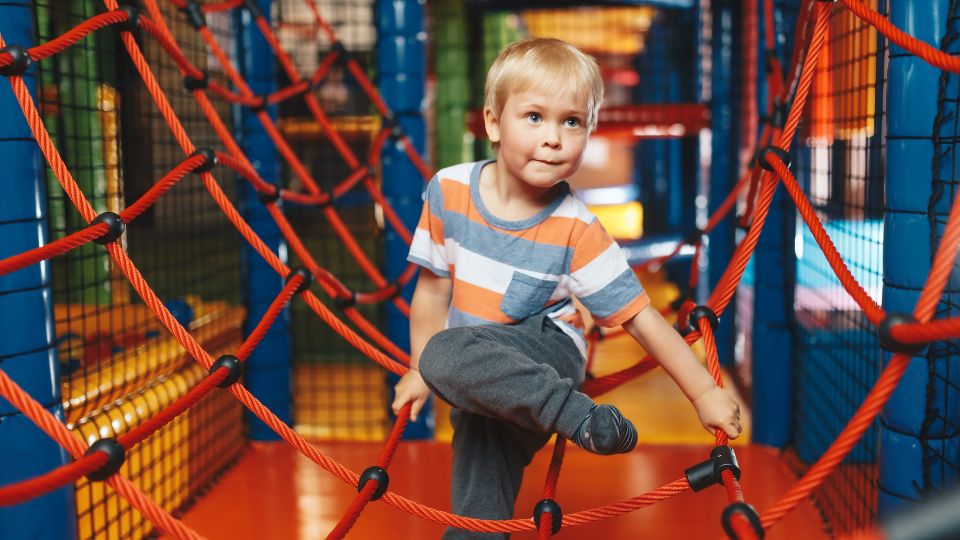
7. Зоны для батутов и мягких прыжков
Что они собой представляют
Крытые батутные секции или зоны прыжков на поролоновых ямах позволяют детям безопасно прыгать на мини-батутах или в ямах с подушками.
Преимущества
- Сердечно-сосудистый фитнес: Прыжки повышают частоту сердечных сокращений при низкой нагрузке.
- Проприоцепция и координация: Занятия по осознанию тела совершенствуют двигательное планирование.
- Высвобождение энергии: Идеально подходит для энергичных детей, чтобы направить движение.
Советы по дизайну
- Окружайте батуты защитной сеткой или мягкими стенками.
- Расположите поролоновые ямы под альпинистскими или воздушными элементами.
- Для обеспечения безопасного использования дайте рекомендации по весу и росту.

8. Музыкальные и звуковые зоны
Что они собой представляют
Музыкальные конструкции включают в себя панели для ксилофона, стены для барабанов, станции колокольного звона и интерактивные звуковые доски.
Преимущества
- Слуховое развитие: Ритмическая игра улучшает слуховые навыки и распознавание ритма.
- Творческое самовыражение: Дети изучают причинно-следственные связи, создавая звуки.
- Инклюзивная игра: Не соревновательный и доступный для разных возрастов и способностей.
Советы по дизайну
- Для изготовления инструментов для улицы используйте прочные металлы или пластик, устойчивые к атмосферным воздействиям.
- Установите панели на разной высоте для малышей и подростков.
- Сочетайте с сидячими местами или тихими зонами, чтобы сбалансировать уровень шума.
9. Балансировочные балки и полосы препятствий
Что они собой представляют
Небольшие балки, ступеньки, доски и невысокие препятствия, создающие мини-полосы препятствий.
Преимущества
- Сила и ловкость: Узкие поверхности мешают балансу и концентрации внимания.
- Последовательное планирование: Дети учатся планировать маршруты и адаптироваться по ходу движения.
- Групповая игра: Игры "Гонки" или "Следуй за лидером" способствуют развитию умения соблюдать очередность.
Советы по дизайну
- Предусмотрено несколько уровней сложности: широкие лучи для начинающих, более узкие - для опытных.
- Используйте хорошо заметные цвета и нескользкие поверхности.
- Интегрируйте с элементами скалодрома или горки, чтобы играть по кругу.
10. Сенсорные тропы и тактильные дорожки
Что они собой представляют
Напольные дорожки, сочетающие различные текстуры и материалы - резиновые коврики, поролоновые бугорки, ковровые покрытия, тактильные плитки.
Преимущества
- Сенсорное исследование: Ходьба босиком или ползание усиливают тактильные ощущения.
- Задействование мелкой моторики: Игры с прослеживанием линий или обводкой краев развивают зрительно-моторную координацию.
- Разумное движение: Медленное, обдуманное плавание способствует осознанию тела и спокойному сосредоточению.
Советы по дизайну
- Позаботьтесь о прочных материалах для пола с антимикробным покрытием.
- Предложите подсказки в виде раскрасок или фигур, чтобы разнообразить путь (например, "прыгай на каждый красный круг").
- Расположите его рядом с уголками для отдыха или чтения, чтобы сделать сенсорный перерыв.
Заключение
Хорошо продуманная крытая игровая площадка сочетает в себе несколько типов конструкций.скалодромы, мягкие игровые зоны, сенсорные панели, зоны ролевых игр, и интерактивные игры-чтобы создать богатую среду, способствующую физическому, когнитивному и социальному развитию. Вдумчиво подобрав и расположив эти элементы, вы сможете спроектировать игровое пространство, которое увлечет любого ребенка - от энергичных скалолазов до фантазеров и искателей сенсорных ощущений.
Если вы собираетесь оборудовать общественный центр, школу или детский сад, не забывайте об этом:
- Баланс между вызовом и безопасностью: Предлагайте варианты для разных возрастных групп и способностей.
- Приоритет - долговечность и гигиена: Выбирайте материалы, которые выдерживают интенсивную эксплуатацию и частую чистку.
- Способствовать инклюзии: Включите сенсорные и ролевые зоны для детей с разными потребностями.
Соблюдая эти рекомендации и правильно подобрав конструкции для крытых игровых площадок, вы создадите динамичную, благоприятную игровую среду, в которой каждый ребенок сможет играйте, учитесь и развивайтесь-Дождь или солнце.

